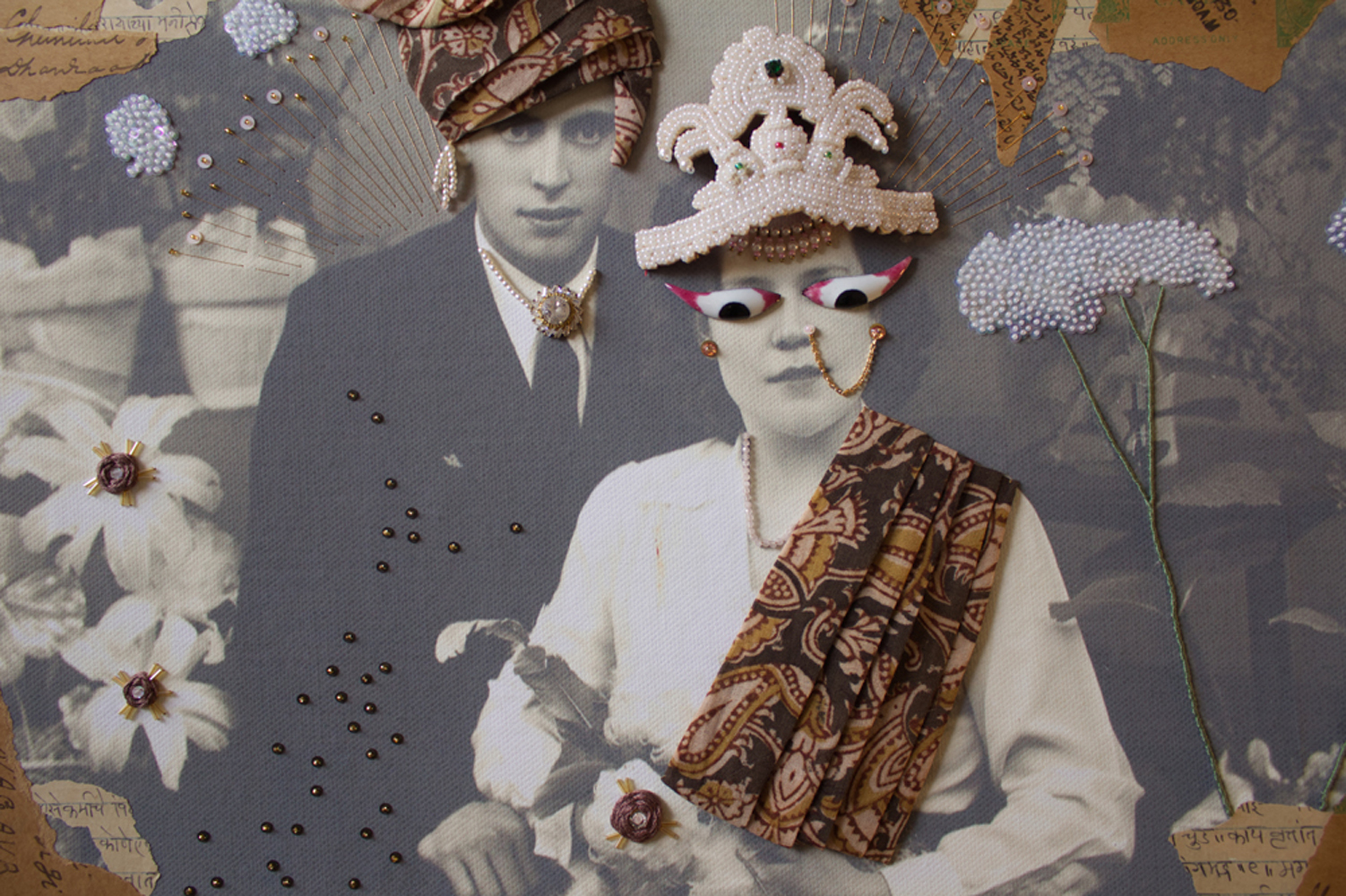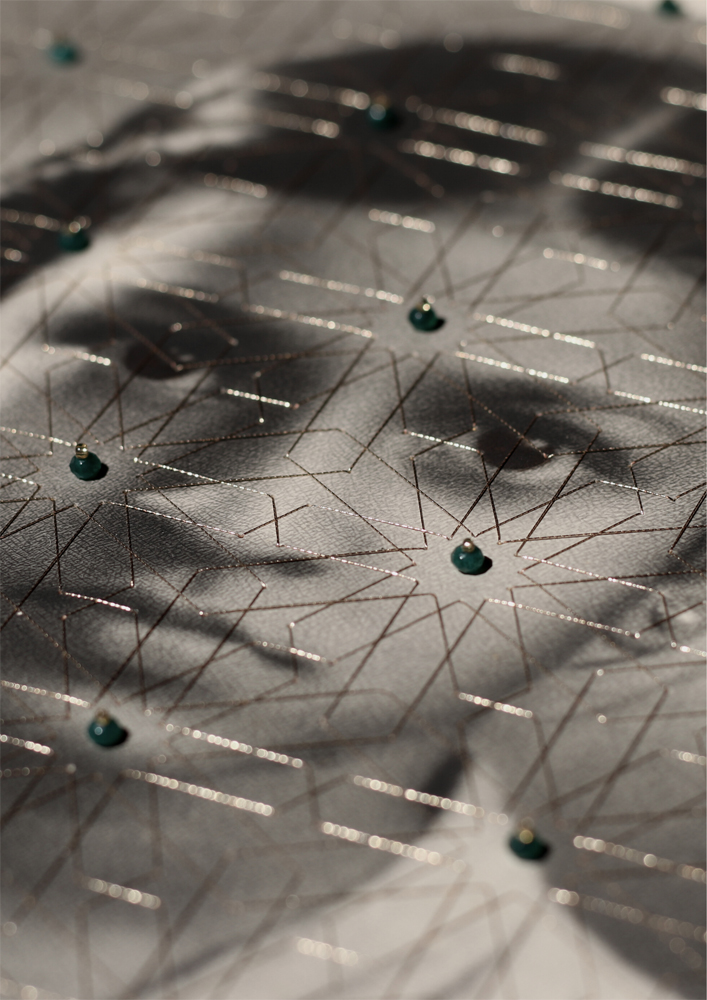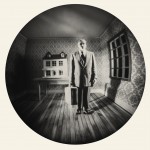Geoffrey Planque: Tracing the contours of invisible tales
I am really excited about Geoffrey Planque’s work because there is something truly unique about how he, as a choreographer, uses the rhythms and movement in his visual art, as well as in his dance. He revitalizes appropriated images that have their own history, creating energy with embroidery, collage, and painting and producing interesting motifs and designs around the figures in the pieces. The French born artist living in India draws influence from Hindu and Islamic culture as well as from Indian painting. His dynamic collages symbolically address questions of religion, life and death, and dreams and nightmares by using embroidery and paint and collage to confine or illuminate the subject.

©Geoffrey Planque, Dancer in the Dark (2021) – Embroidery on black and white photograph, metallic thread, glass beads, ex-voto, dried flowers, sandal paste, enamel. 11,8×11,8cm.
My journey traverses the realm of Indian dances, collages, and embroidery weaving together fragments of the past to create a modern tapestry. Through these practices, I delve into the shared essence that binds them, unraveling the threads that connect tradition, storytelling, and the human experience.
In classical Indian dance forms, I am finding a panel of movement, rhythm, and emotion. The gestures and footwork of this art form serve as my muse, allowing me to communicate narratives and attempt at emotions. The traditional stories and mythologies that Bharata-Natyam and Odissi bring to life become a source of inspiration, feeding my desire to explore the depths of human existence and the timeless truth that resonates across cultures.
Collages become my palette, as I gather fragments of the past. Old photographs, torn pages, and details of forgotten letters find their way into my hands, each carrying a hidden history and a whisper of the lives that once breathed upon them. In the act of assembling these disparate elements, I am re-arranging them to create new narratives, juxtapositions, and connections.
Embroidery serves as a binding medium, allowing me to extend my exploration of found objects and storytelling into the tactile realm. With each stitch, I trace the contours of invisible tales. In the act of embroidering, I find solace as my hands are mindful of this harmonious dance.
The common thread that unites these practices is the essence of preservation. Indian dance preserves tradition, collages preserve narratives, and embroidery preserves an emotion. I invite viewers to immerse themselves in a world of textures, colors, and movements. My work is a study of human condition through my own body. – Geoffrey Planque

©Geoffrey Planque, Hydrangeas of Nagaur (2022) – [What if… series] – Embroidery of a photograph printed on cotton canvas, metallic thread, cotton thread, glass beads, sequins, handwritten manuscript and postcard, kalamkari fabric, gold, found objects. 11,8×15,7in.
Born in France in 1984, Geoffrey Planque is a multi-media artist. His body of work includes dance composition, installation, sculpture and collage. His artistic expressions reflect his blend of Indo-French aesthetics. Over the last two decades, he has dedicated himself to a journey of cultural exploration, through the world of Indian art. His language grew with his study of Fine Arts, Sanskrit theatre, classical dance and folk traditions.
Drawing upon his knowledge of European and Indian aesthetics with a passion for storytelling, he has developed a visual art practice informed by his dance practice. Through the medium of collage, Geoffrey assembles fragments of the past, incorporating old photography, handmade paper, and found manuscripts to construct a language that bring his fictions to life. His process involves embroidery and needle work, lending a tactile dimension to his compositions.
As a choreographer, he incorporates elements from his visual art practice, such as collectibles, beadworks, and found objects, connecting them with threads of meaning. These connections create a melody of dance and visual arts.
Follow Geoffrey Planque on Instagram: @geof_frey_plan_que

©Geoffrey Planque, Gilded cage (2022) – Embroidery on old photograph, transparent watercolor, metallic thread, emeralds. 8,5×11,5in.
GB: Tell us about your childhood and how you became an artist?
GP: I grew up in Lille, the main city of northern France. As a child, I was naturally reserved, often finding solace in silence and solitude. However, this sense of introspection never left me feeling lonely. Instead, it fueled my imagination and allowed me to embark on endless adventures within the depth of my mind. I can also vividly recall the sensations of visiting art exhibitions, museums, magnificent castles, and majestic churches during my formative years. It was during these encounters that my fascination with various subjects began to take shape. Christian themes, with their symbolism, Baroque paintings, and the harmonies of music, all captivated my sensibility. But it was the enchanting allure of mythologies, particularly the captivating depictions of Greek and Roman gods and goddesses, that truly captured my imagination.
In the timeline of my artistic practice, the world of dramatic art holds a significant place. It was quite a revolutionary moment when I discovered the power of this art form. The experience ignited a deep passion within me, inspiring me to pursue a path as an artist. Through y performances on stage, I have immersed myself in a myriad of characters and delved into the depths of psychology, using my body as a vessel for exploration.
During my college years, I embarked on a transformative learning journey of Bharata-Natyam, a traditional performing art originating from Tamil Nadu in South India, where I had the privilege of immersing myself in the context of my Ph. D. on Indian Aesthetics. This unique style of acting and dancing, which I have learned since 2004, incorporates specific techniques that synergize with my physicality and personal artistic interpretations.
During the pandemic, my visual art practice emerged as a response to the void left by the absence of live performances in theatres. It was a period of necessity and an opportunity to explore new creative avenues. In this time, I rediscovered the sheer delight of drawing and painting, rekindling my passion for these art forms. To further enrich my compositions, I began incorporating hand embroidery, adding another layer of texture to my works.

©Geoffrey Planque, Dulaari (2022) – Embroidery on silver nitrate photograph, transparent watercolor, metallic thread, cotton thread, glass beads, bugle beads, sequins, handwritten manuscript, Dulaari song booklet, found objects. 15,7×11,8in.
GB: You are also a choreographer, how does this influence your visual art? Also how does your visual art influence your choreography?
GP: As a mixed-media artist, I embrace a holistic approach to my practice, inherently connecting them with an invisible thread. My exploration revolves around the experience of the body in the process of devotion, religiosity, and veneration. The pieces I produce exist in a thin balance between the sacred and the profane.
Being deeply influenced by Indian traditional dances, I find that devotion remains the aspect that embodies in these art forms, and I strive to capture this essence. Drawing inspiration in Indian aesthetics, my creative pursuits revolve around the fusion of architecture, sculpture, dance, and theatre, all with the shared purpose of cultivating a temple-like atmosphere.
I find inspiration in the Natya-Shastra, an encyclopedic treatise on dramaturgy from India, and the Hindu manuals that prescribe the creation of sculptures and divine images. These texts offer a wealth of concepts that shape both my practices. I combine these traditional elements with my own vision and contemporary influences. During the finalization of my visual art compositions, I incorporate enamel eyes onto my protagonists as the ultimate intervention in my works. This process bears a resemblance to the final step in sculpting in India, which involves intricately carving the eyes onto the sculpture. This act is a ritual, symbolizing the invitation for the deity to reside within their earthly representations. By bestowing eyes upon a divine image, they become witnesses to the world, engaging with it through the Hindu concept of darshan, or ‘vision of the divine’.
Similarly, eyes hold great significance in both my practices, serving as gateways to the soul. In Northern India, this enamel eyes are traditionally added to deities revered in temples and homes. When applied to the protagonists of my photographs, they enable them to conceal emotions, hide them or perceive the world through a fresh perspective.
Within my visual art practice, I craft small, intimate, and profane works that establish a profound connection between myself and the subjects captured in the photographs.
Through my visual art and dance, I aim to elicit a sense of transcendence and spiritual awakening within those who witness and engage with the work. It is my aspiration to create an artistic experience that resonates deep within the soul.

©Geoffrey Planque, Bhakta Kabir (2022) – Embroidery on black mount paper, metallic thread, bugle beads, found paper, acrylic, enamel. 7,8×7,8in.
GB: Talk more about your process and the use of embroidery, beads, collage, and painting?
GP: Paper is my primary medium. With this material, I have the flexibility to experiment with various treatments, like staining, aging, natural dying, watercolor and stenciling. I employ embroidery techniques in my works, which require an approach involving the drafting of specific patterns and perforation of the paper. Due to the fragile nature of paper and its inability to easily undo stitches like textile embroidery permits, each step of the process demands utmost precision and meticulousness.
Within this practice, certain patterns have emerged as leitmotifs, such as clouds and flowers, which infuse a carefree essence into the scenes I create. One notable aspect of my aesthetics is the illumination of the characters. A halo crafted from metal thread or a beaded blood spill can symbolize both a divine light and the eerie presence of death enveloping them. Indeed, death serves as an underlying theme in my creations, accentuated by the incorporation of red beaded tassels or Indian beads made of bone, resembling skulls. The portrayal of death, at times embodies by a single protagonist, is approached with a grotesque touch.
I also incorporate objects such as ex-voto-s into my works. These objects, originating from Catholic tradition, were offered to saints or God as a fulfillment of a vow. Within my compositions, I combine them with torn pages from old books, dried flowers, or rosary beads symbolizing the Christ. This series pays homage to the genre of still life painting, which traditionally features collections of objects symbolizing the inevitability of death.
The world I construct within my artworks is a realm of dreams and nightmares, were my protagonists serve as puppets who convey a sense of lightness, nostalgia, irony, and decadence. By utilizing transparent beads and metallic threads, I create reflections of light that enhance the realism and provide a distinct illumination to the scenes. Furthermore, I infuse a sense of action and movement into my collages. This effect is achieved through the addition of handmade tassels, which create a dynamic visual element, evoking a sense of motion.

©Geoffrey Planque, Kumari (2023) – Embroidery on old photograph, metallic thread, glass beads, bugle beads, cultured pearls, silver, gold, found objects. 6,5×8,5in.
GB: How do you choose images, beads and objects that become a part of the art?
GP: Each of the found objects I am using in my works carries a unique history, having been used, cherished, lost, or left behind, silently harboring memories. The act of collecting them serves two purposes: to appreciate their inherent beauty and to offer them a renewed existence. However, it is important to note that collecting alone does not mark the culmination of my artistic practice. Utilizing these objects in their original form or re-imagining their purpose is essential to my creative process.
The collages I create incorporate photographs from the bygone era, specifically black and white or silver nitrate photographs that originated from photographic studios. These images capture a historical moment when people would pose for the camera, much like they would in a painter’s studio, with a keen sense of aesthetics.
These photographs encompass a range of subjects, including press photography, portraits, and family picture, each depicting pivotal moments in the lives of the individuals portrayed: a melancholic lady, a cunning man, or a sad child. Despite the orchestrated nature of these images, carefully arranged and set in a formal mise-en-scène, the subjects have invested great attention to detail, from their sartorial choices to their posture. Their body language and expressions also reveal genuine emotional states.
By utilizing these portraits as catalysts for my imagination, I uncover a hidden layer within the act of posing for the camera, an underlying truth that may not be explicitly conveyed. My interpretation of these photographs exposes something that is inherently present in the image but often go unnoticed. I incorporate old manuscripts or pieces of postcards into these collages. At times, a protagonist may find themselves partially obscured by layers of paper or covered by a sculpture, effectively erasing their original visage.
I embellish these protagonists in an array of jewels, fabrics, and accessories, treating them as if they were actors on a grand stage. Within these ornamental elements, one can discover crystals, gemstones, and precious metals, each serving a purpose, whether it be adding a pattern to a dress or adorning the neck with a piece of handmade jewelry. These elements serve to bring the protagonists to life and shape the narrative that I have envisioned.
However, it is crucial that these ornamental details never overshadow the plot or hinder its comprehension. Just as the costume of a dancer or actor should never impede their movements, the embellishments should seamlessly integrate into the narrative, enhancing the visual experience without distracting from the story being conveyed.
My works serve as nostalgic recollections of past performances forever illuminated by the passage of time. They also pay tribute to my own ancestors, particularly in the ‘What if…’ series, which portrays my grandparents and my mother. Within this series, I have re-imagined their pictures offering a glimpse of alternative possibilities. It became an opportunity for me to transport them to the vibrant world of India, utilizing floral printed fabrics to create the illusion that my family might have shared an Indian heritage.

©Geoffrey Planque, Sshh (2023) – Embroidery on old photograph, metallic thread, glass beads, bugle beads, handwritten manuscript. 6,5×8,5in.
GB: How do western perspectives on Hindu and Muslim ideas play a part of your work?
GP: As a French artist residing in India, I am immersing myself in the interplay of two distinct cultures, resulting in a syncretism of aesthetics within my works. Through my research and artistic endeavors, I craft a deeply personal interpretation of my experiences in India, drawing inspiration from both European and Indian arts and crafts.
Living in India also entails a captivating encounter with dual cultural dimensions: the Hindu aspect and the Islamic influence brought by the Mughals. The fusion of these two cultures is evident in various facets, particularly in architecture and the exquisite Hindo-Mughal aesthetics.
In the series ‘Begums’, I have created a distinct profile of a woman that has become a signature motif in my practices. This enigmatic face, with suggestive contours but undefined features, can be further adorned with vintage labels, floral printed fabric, or a radiant halo. This series draws inspiration from the tradition of Indian paintings, often referred as miniature paintings by Europeans. Through the use of this figure, my intention is to convey the multifaceted components of Indian history, encompassing both Hindu and Mughal influences. Additionally, it serves as a means to bring visibility to the feminine presence, as the begums were traditionally women of high rank residing within the harem, veiled from public view.
The prominence of the feminine figure in my works serves to underline the historical oppression endured by women for centuries in many parts of the world. Furthermore, some of my artworks get inspiration from sacred geometry, which is an integral part of Islamic aesthetics. The intricate patterns and gemstones embellishments in my photographs create a metaphorical window, portraying these women as imprisoned or confined.
Over the years, I have gained insights into the significant historical events such as the partition of India in 1947, which continues to resonate as a source of political tension today. Consequently, my works also delve into the complexities of identity and the experience of displacement.
Both my artistic practices draw upon the two fundamental concepts rooted in the aesthetics of the stage. The first concept is derived from ancient Greek theatre, known as catharsis. In this context, the aesthetic experience serves as a means of purging and releasing intense emotions and passions. The second concept I incorporate is derived from Sanskrit, known as rasa, which can be understood as the essence or taste of emotion. My journey as an artist encompasses the idea that the aesthetic experience evokes and elicits specific emotional states, allowing the viewers of my works to savor and imbibe the essence of being human.

©Geoffrey Planque, Borderline (2023) – [Begum series] – Embroidery on stamp paper, watercolor, metallic thread, beadwork, enamel. 8,2×11,7in.
Posts on Lenscratch may not be reproduced without the permission of the Lenscratch staff and the photographer.
Recommended
-
The 2024 Lenscratch 3rd Place Student Prize Winner: Mehrdad MirzaieJuly 24th, 2024
-
Charles Shuford: Blue is For BoysJuly 12th, 2024
-
Sarah Lazure: SarahJuly 11th, 2024
-
Kirsten Hoving: Fabricated VisionsJuly 10th, 2024
-
Gary Owens: In the RoomJuly 9th, 2024
































































